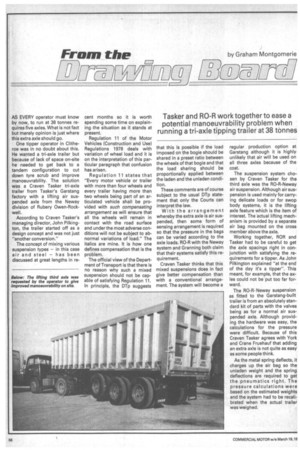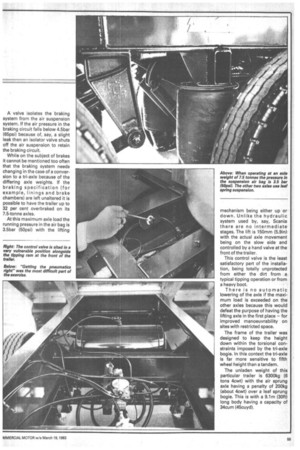From the
Page 60

Page 61

If you've noticed an error in this article please click here to report it so we can fix it.
by Graham Montgomerie
[IC' 0 dfiroi/
Tasker and RO-R work together to ease a potential manoeuvrability problem when running a tri-axle tipping trailer at 38 tonnes
AS EVERY operator must know by now, to run at 38 tonnes requires five axles. What is not fact but merely opinion is just where this extra axle should go.
One tipper operator in Clitheroe was in no doubt about this. He wanted a tri-axle trailer but because of lack of space on-site he needed to get back to a tandem configuration to cut down tyre scrub and improve manoeuvrability. The solution was a Craven Tasker tri-axle trailer from Tasker's Garstang factory with a lifting air suspended axle from the Neway division of Rubery Owen-Rockwell.
According to Craven Tasker's managing director, John Pilkington, the trailer started off as a design concept and was not just "another conversion."
The concept of mixing various suspension types — in this case air and steel — has been discussed at great lengths in re cent months so it is worth spending some time on explaining the situation as it stands at present.
Regulation 11 of the Motor Vehicles (Construction and Use) Regulations 1978 deals with variation of wheel load and it is on the interpretation of this particular paragraph that confusion has arisen.
Regulation 11 states that "Every motor vehicle or trailer with more than four wheels and every trailer having more than two wheels being part of an articulated vehicle shall be provided with such compensating arrangement as will ensure that all the wheels will remain in contact with the road surface and under the most adverse conditions will not be subject to abnormal variations of load." The italics are mine. It is how one defines compensation that is the problem.
The official view of the Department of Transport is that there is no reason why such a mixed suspension should not be capable of satisfying Regulation 11. In principle, the DTp suggests that this is possible if the load imposed on the bogie should be shared in a preset ratio between the wheels of that bogie and that the load sharing should be proportionally applied between the laden and the unladen condition.
These comments are of course subject to the usual DTp statement that only the Courts can interpret the law.
With the arrangement whereby the extra axle is air suspended, then some form of sensing arrangement is required so that the pressure in the bags can be varied according to the axle loads. RO-R with the Neway system and Granning both claim that their systems satisfy this requirement.
Craven Tasker thinks that this mixed suspensions does in fact give better compensation than with a conventional arrangement. The system will become a regular production option at Garstang although it is highly unlikely that air will be used on all three axles because of the cost.
The suspension system chosen by Craven Tasker for the third axle was the RO-R-Neway air suspension. Although air suspension is used mainly for carrying delicate loads or for swop body systems, it is the lifting axle feature which is the item of interest. The actual lifting mechanism is provided by a separate air bag mounted on the cross member above the axle.
Working together, ROR and Tasker had to be careful to get the axle spacings right in conjunction with satisfying the requirements for a tipper. As John Pilkington explained "at the end of the day it's a tipper". This meant, for example, that the axles could not be put too far forward.
The RO-RNeway suspension as fitted to the Garstang-built trailer is from an absolutely standard kit of parts with the valves being as for a normal air suspended axle. Although providing the hardware was easy, the calculations for the pressure were difficult. Because of this Craven Tasker agrees with York and Crane Fruehauf that adding an extra axle is not quite as easy as some people think.
As the metal spring deflects, it charges up the air bag so the unladen weight and the spring deflections are required to get the pneumatics right. The pressure calculations were based on the estimated weights and the system had to be recalibrated when the actual trailer was weighed.
A valve isolates the braking system from the air suspension system. If the air pressure in the braking circuit falls below 4.5bar (65psi) because of, say, a slight leak then an isolator valve shuts off the air suspension to retain the braking circuit.
While on the subject of brakes it cannot be mentioned too often that the braking system needs changing in the case of a conversion to a tri-axle because of the differing axle weights. If the braking specification (for example, linings and brake chambers) are left unaltered it is possible to have the trailer up to 32 per cent overbraked on its 7.5-tonne axles.
At this maximum axle load the running pressure in the air bag is 3.5bar (50psi) with the lifting mechanism being either up or down. Unlike the hydraulic system used by, say, Scania there are no intermediate stages. The lift is 150mm (5.9in) with the actual axle movement being on the slow side and controlled by a hand valve at the front of the trailer.
This control valve is the least satisfactory part of the installation, being totally unprotected from either the dirt from a typical tipping operation or from a heavy boot.
There is no automatic lowering of the axle if the maximum load is exceeded on the other axles because this would defeat the purpose of having the lifting axle in the first place — for improved manoeuvrability on sites with restricted space.
The frame of the trailer was designed to keep the height down within the torsional constraints imposed by the tri-axle bogie. In this context the tri-axle is far more sensitive to fifth wheel height than a tandem.
The unladen weight of this particular trailer is 6300kg (6 tons 4cwt) with the air sprung axle having a penalty of 200kg (about 4cwt) over a leaf sprung bogie. This is with a 9.1m (30ft) long body having a capacity of 34cum (45cuyd).












































































































